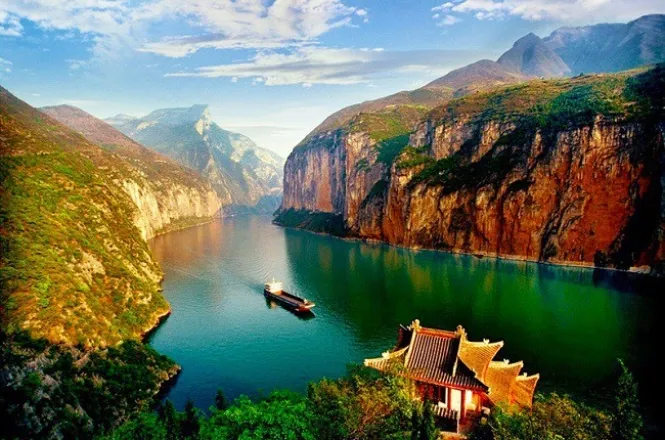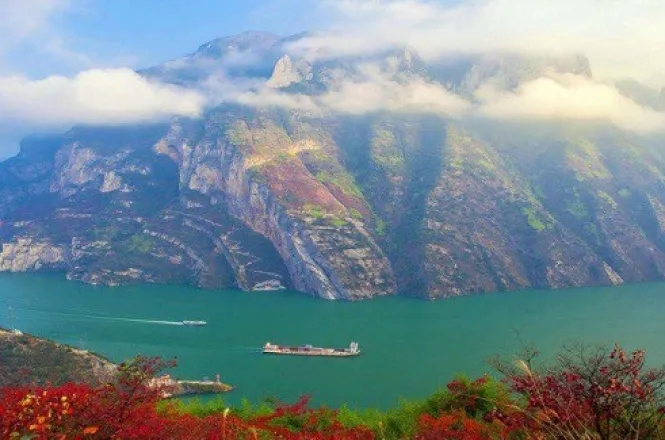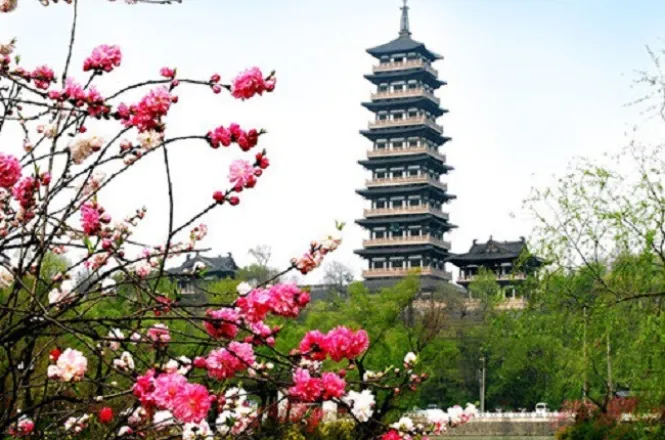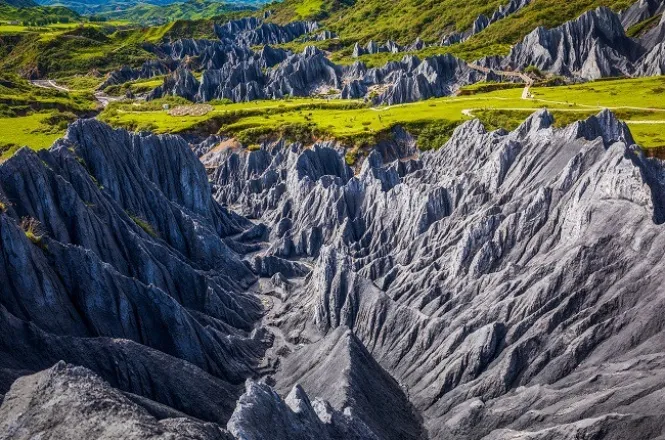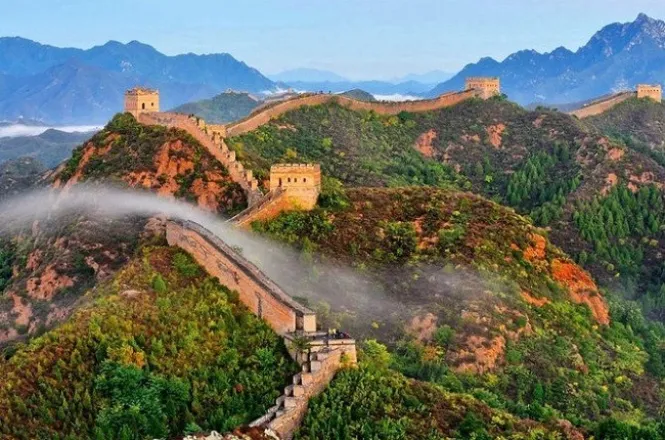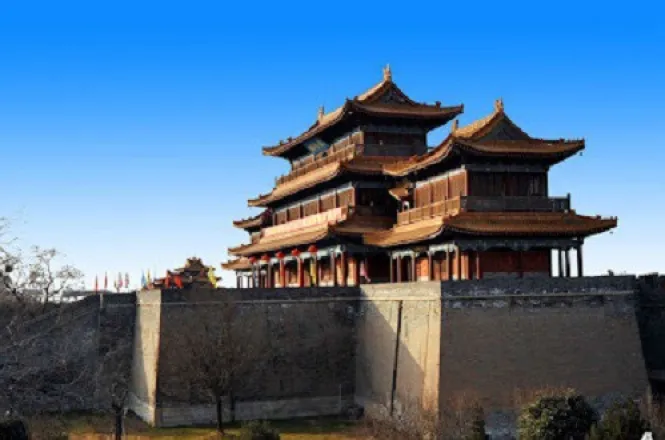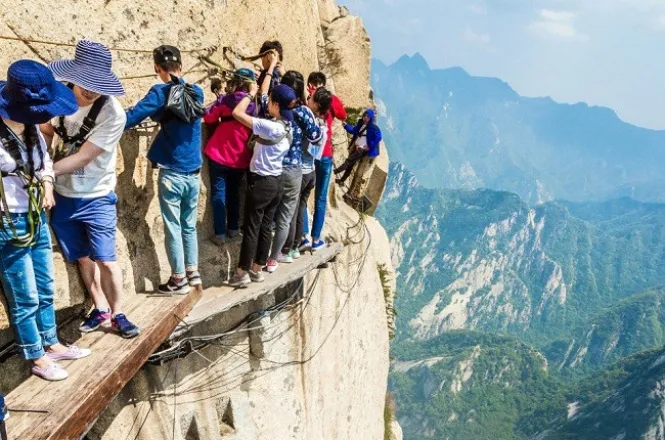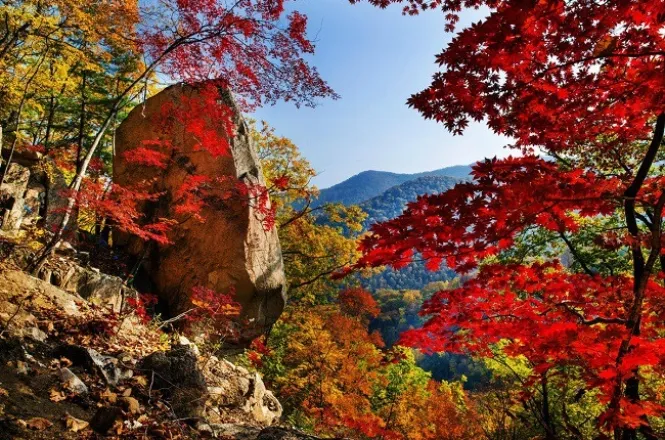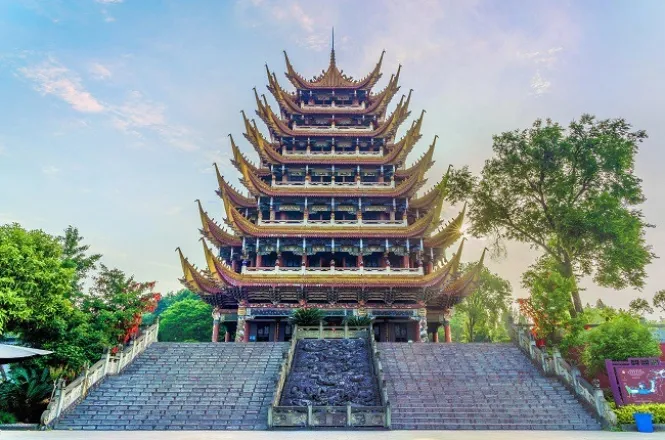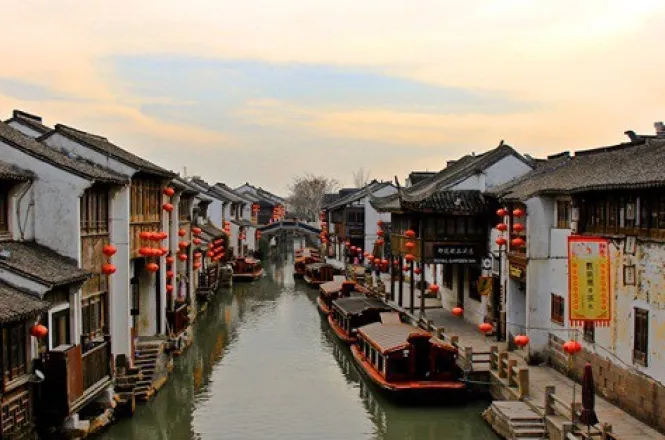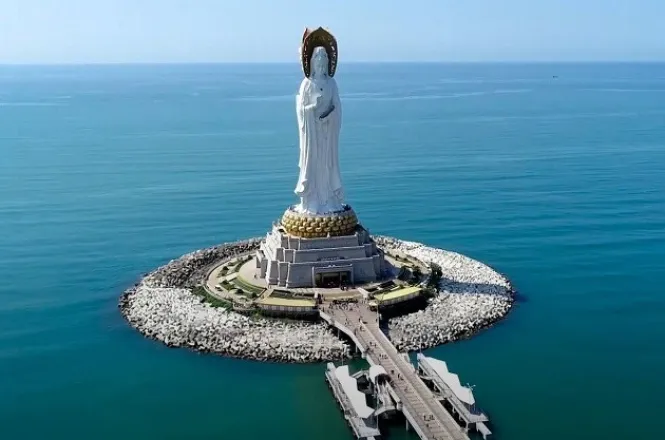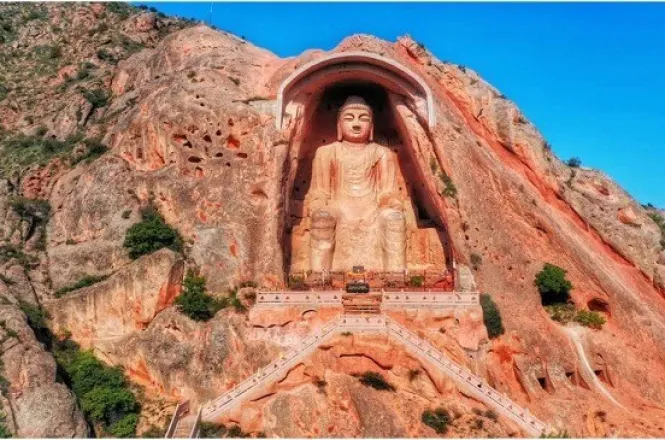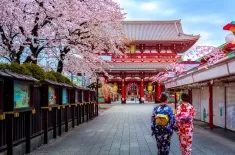Tempat Terbaik untuk Dikunjungi di Cina
Cina adalah tujuan wisata yang hebat karena ukurannya yang tipis. Negara ini menawarkan berbagai pengalaman luar biasa dan peluang jalan-jalan, apakah Anda ingin berlayar melintasi Ngarai Yangtze yang indah, menjelajahi kota yang semarak, atau sekadar bersantai di kuil kuno yang tenang.
Sejak penemuan Cina oleh Marco Polo, seorang petualang lebih dari 700 tahun yang lalu dalam sejarah Cina, negara besar Asia telah dianggap sebagai lambang eksotis dan misterius. Negara yang luas ini masih mempesona, bahkan setelah puluhan tahun mengalami pertumbuhan ekonomi. Kontras antara tradisi kuno China dan negara modern hanya menambah daya tarik budaya yang telah ada selama ribuan tahun.
Budaya ini sangat dijunjung tinggi oleh orang Tionghoa, seperti yang ditunjukkan oleh pelestarian situs-situs bersejarah penting seperti kota Terlarang dan Istana Musim Panas di Beijing. Setiap situs mengingatkan hari-hari kaisar Tiongkok. Tembok Besar yang terkenal membentang 6.700 km dari Laut Kuning ke Asia Tengah. Banyak kuilnya mencerminkan semangat agama-agama Timur kuno.
Cina adalah tujuan wisata yang hebat karena ukurannya yang tipis. Negara ini menawarkan berbagai pengalaman luar biasa dan peluang jalan-jalan, apakah Anda ingin berlayar melintasi Ngarai Yangtze yang indah, menjelajahi kota yang semarak, atau sekadar bersantai di kuil kuno yang tenang.
Jelajahi tempat-tempat wisata paling populer di China untuk menemukan hal-hal baru dan menarik.
1. Xi'An City
Xian CityXi'an is a popular destination for foreign tourists, and it's a great choice for those who are just starting to travel to China. One of the most important archaeological sites in the world is the Terracotta Army, located in Xi'an. There are more than 6,000 life-size Terracotta warriors, horses and terracotta soldiers. They all have different expressions and poses. Many more are still in storage.
In the 1970s, farmers were digging wells near Xi'an when they discovered what would be China's most significant archeological discovery: the Terracotta Army. The Terracotta Army was found in three large underground pits. It was meant to protect the First Emperor's tomb.
While some statues were badly damaged by the passage of time, many of them have been meticulously reassembled. They are a testament to the honor bestowed on the Emperor and the Afterlife. This site is part of the Emperor Qin Shi Huang’s Mausoleum Site Park. It offers an unforgettable experience to stand in front of these soldiers and horses, as if you were watching a centuries-old parade. English-language guided tours are also available.
Address: Lintong District, Xi'an, Shaanxi, China
Top Things to Do In Xi'an :
- Visit the Terracotta Army to make your own warriors in a cave dwelling.
- Ride a bicycle on the Ancient City Wall.
- You can relax and eat in the Muslim Streets.
Three Gorges of the Yangtze River
Three Gorges is the most famous section of the Yangtze's navigable reaches. It also contains the Three Gorges Dam. These natural and cultural attractions are part of a Yangtze Cruise that takes you from Chongqing to Yichang in the middle reaches.
The idea of the Three Gorges Dam was first discussed in 1920s by leaders of the Chinese Nationalist Party. In 1953, Chinese leader Mao Zedong ordered feasibility study of several sites. The detailed planning of the project started in 1955. Although the dam's supporters claimed it would prevent flooding along the Yangtze and facilitate inland trade, as well as providing much-needed power to central China, there were also critics.
The Three Gorges project was subject to criticism from the beginning of its conception and throughout its construction. The danger of a dam collapse, displacement of approximately 1.3 million people (critics insist the figure is actually 1.9million), living in more than 1,500 towns and villages along the river and destruction of stunning scenery and many rare architectural and archaeological sites were the key problems.
Some of the fears were also confirmed, including that human and industrial waste from the cities could pollute the reservoir. The reservoir's large volume of water could also trigger earthquakes or landslides. Chinese and foreign engineers suggested that smaller, more efficient and less problematic dams could be built on the Yangtze tributaries to generate the same power as the Three Gorges Dam. They also would control flooding as well. They claimed that construction of these dams would allow the government to address its primary priorities without taking on any risks.
These problems caused work on Three Gorges Dam to be delayed for almost 40 years while the Chinese government tried to decide whether or not to proceed with the plans. Although Premier Li Peng was an engineer by training, he managed to convince the National People's Congress in 1992 to approve the decision to build it. However, almost a third or more of the members abstained from voting against it, which is an unusual sign of resistance for an normally passive body. The official inauguration ceremony of the dam was held in 1994 without President Jiang Zemin. In addition, the World Bank declined to provide China with funds for the project due to major environmental concerns.
The Three Gorges project continued to move forward. 1993 saw the construction of access roads to the site and electricity. In 1997 workers blocked the river and diverted it, closing the first phase. The reservoir started to fill in 2003. In the meantime, the ship locks, which allowed ships of up to 10,000 tonnes to pass the dam, were put into operation. Finally, the first generator connected to the grid completed the second phase. After the completion of this second phase, approximately 1,200 historical and archaeological sites that used to line the Yangtze River's middle reaches vanished due to rising floodwaters. 2006 saw the completion of construction of the dam's main wall. In 2006, the remaining generators of the dam were in operation. A ship lift, which allows vessels up to 3,000 tonnes to bypass the ship locks to navigate past the dam more efficiently, was operational in late 2015.
2. Qutang Gorge
Qutang Gorge, the first of the Three Gorges along the Yangtze River is spectacular. It is the shortest but highest of the Three Gorges. It is often referred to as the Yangtze River's gateway.
Localization
Qutang Gorge lies approximately 500km (300 miles) northeast of Chongqing City, and 200km (130 miles) downstream from Yichang in Central China. The gorge runs 8 km (5 miles) downstream of Baidicheng (White Emperor City), Fengjie County in Chongqing.
Features
Kuimen (Kui Gate)
Two bluffs are located at the western end Qutang Gorge. They rise steeply up to more than 1300m (4300 feet) each side of the Yangtze River. The Yangtze River measures only 100m (328 feet) to 200m (656 feet), and the narrowest point, 50m (164 feet), is located here. Two bluffs at the Yangtze River look like an open gate. They are called Kuimen or Kui Gate. (Fengjie County used to be called Kui in ancient times). These are the other.
Kuimen is a landmark on the Yangtze River. Qutang Gorge can also be called Kui Gorge. It is the "gate to the Three Gorges" if you go downstream. Kui Gate is almost 90 degrees in angle and steep. It is truly amazing to see.
When the Yangtze River passes Kuimen, it becomes a narrow belt. The Kuimen Gate water level rose by 130m (430ft) after the Three Gorges Dam was built. The gate's peaks are still approximately 1100m (3608ft) above the river level.
Rhinoceros Viewing the Moon
A large stone is located on the top of a mountain at the northern bank of Qutang Gorge. It looks like a rhinoceros looking west at Kuimen. The stone looks almost like a rhinoceros looking at the moon when the moon is in west at night. It is known as Rhinoceros viewing the Moon, and it is a famous sight in Qutang Gorge.
Qutang Gorge is home to many historical and cultural sites, including Baidicheng (White Emperor City), where many famous Chinese poets lived. Also, cliff inscriptions from the past dynasties, and the former residence for Dufu, a famous Chinese poet.
Tourist Activities
- Many Yangtze River Cruises include a shore excursion into White Emperor City.
- Photography. Photography. Qutang Gorge is one of the Three Gorges that is the shortest. To avoid missing Qutang Gorge's highlights, such as Kui Gate or Rhinoceros Viewing of the Moon, you should plan ahead.
3. Wu Gorge
Wu Gorge, the second of Three Gorges through which flows the Yangtze River, is also known as Ba Gorge. In ancient times, it was also known as Ba Gorge. It is the most charming and graceful of the Three Gorges. It is known for its forests covered mountains, changing clouds and mists that wreath around the tops. It is a favorite of Chinese poets, and has inspired many sentimental and well-known poems.
Wu Gorge rises approximately 1000m (3280 feet) above the river level. The water level in Wu Gorge increased by 80m (262 feet) after the Three Gorges Dam was built. Although the water level rose about 80 meters (262 feet) in Wu Gorge after the construction of the Three Gorges Dam, it did not affect the beauty and grace of Wu Gorge.
Location
Wu Gorge runs 44 km (27 miles), from Wushan County in Chongqing Province, to Badong County in Hubei Province. It is located approximately 500km (300 miles) northeast of Chongqing City, along the Yangtze River, and 150km (100 miles) upriver at Yichang in Central China.
Features
Wu Gorge's length and width are both short and the amount of sunlight is limited. This means that the humidity in the gorge is prone to cloud formations and mists. They can sometimes be seen hovering around the peaks, creating a variety of shapes and even accompanied by Buddha’s light (an optical phenomenon that is visible on high mountains covered in clouds). The phenomenon creates a colorful halo around the observer's shadow. This is often used to indicate the observer having experienced personal enlightenment, which can be associated with Buddha or other divinities. Wu Gorge looks more mysterious and fascinating when there are mists and clouds swirling about.
The Twelve Peaks of Wushan (Wu Mountain), which are located on both sides of Wu Gorge, is the most beautiful scenic spot in Wu Gorge. The most well-known is Shenv Peak (Goddess Peak). It looks like a graceful, slim, and graceful girl standing in the mist and cloud. According to Chinese legends, she was once a goddess that controlled floods and helped people. It faces east and is the first to receive the alpenglow, and the last one to enjoy the afterglow. It is also known as Wangxia Peak (Viewing Morning or Evening Glow Peak).
4. Xiling Gorge
Xiling Gorge (66 km) is the longest of all Three Gorges, compared with Wu Gorge (44 kilometers) and Qutang Gorge (8 kilometer). Before the Three Gorges Dam Project was completed, Xiling Gorge was known for its narrow waterways that abruptly narrowed into dangerous rapids or skirted dangerous shoals.
Location
From the mouth of Xiangxi River, Zigui County, to Nanjin Pass in Yichang City, Xiling Gorges runs west to west. It was named after Mt. Xiling. Badong, Zigui, and Yichang are the three cities that lie along Xiling Gorge. Right in front of Xiling Gorge is the Three Gorges Dam.
Features
Xiling Gorge, the last of Three Gorges, is where one sails down from the Yangtze. It marks the end to the narrow, twisting, and turning corridor that was so dangerous in the past. The Gezhou Dam Water Conservancy Program has helped to calm the water.
Despite the dangers, Xiling Gorge was dubbed a "death passage". It was the only alternative. Ships had to navigate its waters frequently. The Three Gorges Dam was built for these reasons and many other reasons. It transformed what was once a "dealth path", where many ships were aground and some were even destroyed completely, into a gentle waterway whose surface can more accurately be compared with the calm waters of a lake.
The Yangtze widens beyond the Xiling Gorge into a smooth, flat waterway that is easy-to-follow. Many historical sites can be found along Xiling Gorge, including the Huangling Temple, which was built in the Three Kingdoms Period more than 1,800 years ago. Quyuan ancestral Hall is an old temple to honour the memory of Quyuan who was a great patriotic poet of ancient times. The former residence of Wangzhaojun.
5. Daming Temple at Yangzhou
Daming Temple, located in the northwest part of Yangzhou City in Jiangsu Province is where Jianzhen, a monk in Tang Dynasty (618-907), performed Buddhist rituals. It was designated one of the national key temples of the Han area in 1983.
Daming Temple was constructed during the Daming reign (457-464). It was therefore named Daming Temple. Daming Temple was named several times. This temple was called Xiling Temple because it contained a pagoda that could enshrine Buddhist relics, the Xiling (Soul Living Pagoda) Pagoda. It was also known as West Temple by the people because it was located west of Sui Empire's palace.
In 1765, Emperor Qianlong made a southward inspection tour during the Qing Dynasty (1644-1911). This temple was given the name Fajing when Emperor Qianlong arrived. The Statue of Jianzhen, which was originally named Fajing, was moved from Japan to China in 1980. Daming Temple's peak was reached in the Qing Dynasty, when Emperors Kangxi (and Qianlong) visited Yangzhou City multiple times. Its scale grew in size unabated, eventually becoming one of Yangzhou City’s Big Eight Temples during the Qing Dynasty.
Jianzhen was a skilled monk of the Tang Dynasty and served as abbot at Daming Temple in order to continue Buddhist teachings. Jianzhen attempted to travel across the ocean to Japan to introduce Buddhist doctrines in the second year of Tianbao's Tang Dynasty reign. He failed. He tried again and again. After five failed attempts, he finally succeeded in the Tianbao reign's twelfth. Jianzhen's arrival to Japan in the twelfth year of the Tianbao reign after five failures brought new life to Japanese culture. He also made significant contributions to Sino-Japan cultural interchanges. Jianzhen Memorial was constructed in Daming Temple to honor him in 1973. This memorial was inspired by buildings from the Tang Dynasty and was designed in China by Liang Sicheng. In the Main Hall of this memorial is enshrined the Statue of Jianzhen.
You will also find Pailou (decorated archedway), Main Hall Sutra Hall, OuyangXiu Hall, and many other halls. Daming Temple The Main Hall is home to the Statue Of Sakyamuni, which can be found in the middle. Eighteen arhats are located on the left and right sides. Many people visit this place before the New Year's Day every year to worship Buddha and burn joss sticks. Some Japanese tourists also come to ring the bell to pray for safety and happiness.
6. Moshi Park, Ganzi Tibetan Autonomous Prefecture
It is located at 3,500m above sea level and is known for its stone forests of mylonite, which were formed thousands of years ago. Ganzi recently announced a series of preferential policies to encourage winter and spring tourism. These include free entry to all scenic spots, half-price hotels rooms, and discounted airfares.
7. Jinshanling Great Wall, Beijing
For an easier climb, Jinshanling Great Wall was restored. You can hike from Jinshanling to Simatai West. The Great Wall at Jinshanling is a complete defense system that includes watchtowers and gun emplacements as well as barrier walls, battlement walls and watchtowers. It also has shooting holes, horse blocking walls, branch cities, and gun emplacements. It is also known as the "paradise for photographers". It is located about 130 km (80 miles) northeast from Beijing downtown. Visitors can take a bus to Wangjing West Subway Station.
The Great Wall of China is one of The 7 New Wonders of The World. It is the longest structure built man-made on Earth and was constructed by more than 1 000 000 civilians, soldiers, and convicts.
The Great Wall at Jinshanling was originally built in 1368-1389 during the Ming Dynasty (1368-1644). In 1567 and 1570, rebuilding was mostly directed by General Qi Jiguang (1528-1588).
There are poems and tablet writings on the Great Wall, which dates back to Qi Jiguang's time of rebuilding.
Architectural Features -- 31 Watchtowers. Original Wall Dimensions: 5.1 km (5.2 miles). Average height 7 meters, average width 5 meters. Watchtowers with dense spacing: 31 towers are located approximately one every 150 m. Each tower is between 5-8 meter high.
31 Watchtowers
This section is notable for its 31 watchtowers. The different terrain dictated that watchtowers could be built in various shapes. They could be tall, short, square or rectangular, and have three to five embrasures. The majority of watchtowers have one to two floors.
An unusual three-floor watchtower is located at the western end of Jinshanling Section (which is unfortunately a military restricted area).
The Best Time to Visit
Jinshanling's scenery is a mix of seasons. Spring and autumn are the best times to visit Jinshanling. The Wall can be seen from below in the mornings of spring or summer. It can get very hot at the Great Wall during summer. For the beautiful green mountains and comfort, May and June are the best month to visit.
Our customers are advised to avoid China's major holidays, when the wall is crowded with Chinese tourists.
- National Day Holiday (October 1-7).
- Labor Day Holiday (May 3 - 3)
Jinshanling Great Wall Hiking Routes
- Route 1: From Zhuanduokou Pass via General Tower to Shalingkou Pass. It takes approximately 1.5 hours to complete the trip, which is 3 km (2 miles). You can then descend the mountain via Shalingkou Pass.
- Route 2: This route may be taken from Zhuanduokou Pass via General Tower or Shalingkou Pass to Small Jinshan Tower. You can then take a cable car down to the top of the mountain. It takes approximately 2 hours to hike the 4km (2.5 mile) distance.
- Route 3: Hike from Zhuanduokou Pass via Shalingkou Pass and General Tower to Houchuankou Pass. It takes approximately 5km (3 miles) to complete the entire journey. Hikers can expect to take around 3 hours to complete it. You can return to Jinshan Horse Track after the visit.
- Route 4: You can start hiking at Shalingkou Pass. Continue on to the Small and Big Jinshan Towers, Houchuankou Pass and Eastern Five-window Towers. Bricks with characters and Kylin Screen Wall are also included in this route. You can also descend the mountain to the east gate. It takes approximately 4 hours to complete the route, which is 7km (4 miles).
8. Huashan North Peak
Xiyue Temple, located at the foot Mount Huashan is 120km (about 74.56 miles) east of Xi'an City. Built to honor Emperor Wudi, the Western Han Dynasty's ruler between 206 BC and 24 AD, it was constructed in his honor. Many emperors have offered sacrifice here to the god on the mountain since then.
Because of its constructions, and overall composition, Xiyue Temple has been called the Forbidden city of Shaanxi. It faces towards Mount Huashan and is a must-see spot for those who are starting or finishing climbing the mountain. These buildings include Haoling Gate and Five-Phoenix Pavilion as well as Lingxing Gate and Golden City Gate.
Haoling Gate
Haoling Gate is known as the Three Linking Gate because it has three doors that are linked together. Two delicately carved stone-lion lions flank the gate, and two stones with the message "Everyone should dismount here" are also found. Haoling Gate is surrounded by a glazed screen wall measuring 30 meters (6 meters (19.7 feet) in length and 6 meters (16.7 ft high).
Defensive Enclosure (Weng Cheng)
You will find yourself in the Defensive Enclosure once you have entered Haoling Gate. The Defensive Enclosure's north boundary is the Five-Phoenix Pavilion (also known as Meridian Gate (Wumen), which serves as the front gate to Xiyue Temple. It is a 20-meter high (about 65.6 feet) brick structure built in the Ming Dynasty (1136 - 1644). Five linked doors lead to the pavilion. The roofs of these doorways are approximately 4 meters wide (about 13 feet) and 5 meters high (about 16.4ft). A magnificent wooden pavilion with many rooms is located on the doorways. It has glazed eaves and is decorated with beautiful wood. Two delicate side-buildings are located to the west and east of the pavilion. You can view the entire temple by passing through the berms on both sides of Five-Phoenix Pavilion.
Small Steles Forest
Many steles can be found behind the Five-Phoenix Pavilion. Mount Huashan Monument, the most well-known stele in the universe, was erected here by Emperor Xuanzong during his visit to the mountain during the Tang Dynasty (618 – 907). The stele is only three meters (9.8 ft) long and has been covered in line engravings of beasts. The base of the stele consists of two large stones that are connected with iron cord. A magnificent relief depicting heroes in golden corselet is found around the base.
Other steles erected in this area by prestigious figures are also preserved, including Hieron Stele Mount Huashan of Northern Zhou Dynasty (557 – 581), stele Xiyue Temple Restorations of the Ming Dynasty (1136 – 1644) and Lingshu Steles of the Qing Dynasty (1644 – 1911). Here is preserved the largest accumbent Stele in Shaanxi Province. It was written by Emperor Qianlong, Qing Dynasty. The yard behind Five-Phoenix Pavilion was once known as the Shaanxi Musem of Small Steles Forest because of the large number of steles.
Lingxing Gate
Lingxing Gate leads to the second courtyard of the temple. Lingxing is named after Lingxing, a god who rules over the heavens. Lingxing Gate, a wooden structure with three linked arches decorated in glaze, is made of wood. The nine dragon heads carved into the bucket arches of this building make it a unique structure. The three linked archways, which are reminiscent of a royal palace, are made with red pillars and yellow glazed tiles.
Stone Archway
You will find a high-strung stone archway after passing through the Lingxing Gate. It is the Heaven Authority Close Stone Archway (Tianweizhichi Archway), which is the oldest and most well-preserved stone archway. It is made with stone girders and pillars as well as square-columns. It was built during the reigning of Emperor Shenzong, the Ming Dynasty. It is full of relief, line engraving and fretwork. It has three layers, each with delicately decorated sculptures of the mighty Lion holding a vase, flowers and vines on its roof, and dragons carved around it. Fairies are also adorned in the angles. There are two other archways to the west and east of the majestic gate. The pavilions' side palaces are Hades Palace, and Divine Palace.
Golden City Gate
The second-largest building in the temple is Golden City Gate. Golden City Gate measures 11.76 meters high and is made of giant bucket arches and other materials. The Golden Water Bridge, built during the Ming Dynasty, is located to the north of Golden City Gate.
Haoling Palace
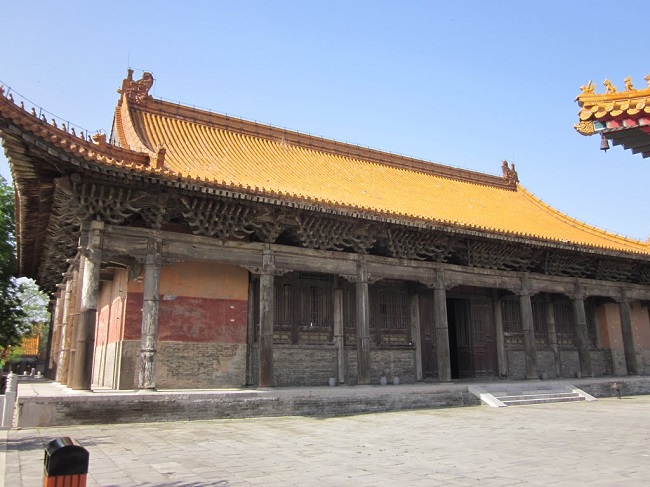
The main hall of Xiyue Temple is located north of Golden Water Bridge in Haoling Palace. It is made up of 68 giant columns, nine crossbeams, and 18 glazed crosscanopies.
A T-shaped platform is located in front of Haoling Palace. From the platform, a Royal Route (main route), is covered in bluestone and leads to the yard. The Royal Route is clearly marked by the different grades of Side Route, Noble Route and Guest Route. On both sides of Royal Route, there are Steles of Maps of Mount Huashan & Maps of Xiyue Temple.
The memorial tablet of Huashan God can be sacrificed in the palace. The palace houses a number of noble steles, including one inscribed by Emperor Tongzhi (1856-1875), and Emperor Guangxu (1871-181908) of late Qing Dynasty, and another by Empress Dowager Cixi (1935-1908).
Emperor's Study
The Emperor's Study was where the Qing Dynasty's emperors kept their books. It was built during the reign Emperor Qianlong and is a delicate wooden attic structure with overlapping eaves and glazed windows. There is a large tablet in the study on which Emperor Qianlong wrote four characters: "Yue Lian Ling Shu", meaning Mount Huashan can bless timely rains.
Long Live Pavilion
The Long Live Pavilion is located at the back of temple. It is the highest point of the temple. It has three floors. The Yellow River can be seen from the top of this pavilion. It is also known as the Yellow River Watching Pavilion. There were originally two Pavilions of Buddhist Sutra near the pavilion. They have since been destroyed.
You can also visit the Emperor's Resting Palas and the Royal Garden.
9. Jade Spring Temple (Yuquan Temple)
Jade Spring Temple, one of the most popular attractions in Xi'an City is a must-see when visiting Mount Huashan. Jade Spring Temple is considered the gateway to the mountain by many. It is a Taoist Temple and hosts Taoist activities and practices. It was built by Emperor Shenzong of the Northern Song Dynasty (960-1127), to honor Chen Tuan (871-989), a scholar and eremite from the Quanzhen School (a branch Taoism), Jia Desheng, who was a student of Chen. Chen Tuan was once called Mr. Xiyi, by an emperor. People call him "Taoism Mother Chen Tuan", or "Sleeping Fairy" (Taoism father Xiyi). He combined the ideologies of Quietism and Taoism with Confucianism, Confucianism, Buddhism, and Confucianism to make great contributions to the development neo-Confucianism. This Confucian School of ideal Philosophy in the Song Dynasties (960 -1279).
According to a charming legend, the current name of the temple is derived from the fact that the Golden Fairy Princess accidentally dropped her jade hair clasp into Mount Huashan Guarding Palace's Jade Well. She eventually found it in the temple when she washed with spring water. The Jade Well was connected to the spring, so the princess named it Jade Spring.
A long corridor surrounds the temple. This feature is the most unique of all temple constructions. It was carefully designed in accordance with the seventy two phenological phenomena found in the Chinese annals. The windows come in both square and round shapes. There are 72 patterns on the windows. These include flowers, plants, insects, fish and so forth.
These constructions are divided into three parts: the east, middle and west.
Tomb of Hua Tuo
The tombstone of Hua Tuo (145-208), a skilled Eastern Han Dynasty doctor (25-222), can be found in the east. According to legend, Hua Tuo visited his friend Mr. Lu in Mount Huashan. Together they collected herbs, made medicines, and saved lives. Cao Cao, a militarist who founded Kingdom Wei of Three Kingdom Period, wrongly murdered Hua Tuo. His ghost then went to Lu and informed him about the injustice. As Hua's death was confirmed, Lu later built a cenotaph at Red Rock Village. The original tomb is gone today, but it remains a mystery as to how and when the tombstone was moved into the temple.
Xiyi Hall
The main body of Jade Spring Temple is located in the middle of the hall. Its main building is Xiyi Hall, a quadrangle-style structure. The hall can be divided into two parts: the front and back palaces.
The statue of Hao Datong, the founder of Mount Huashan School for Taoism, is located in the front palace. Outside the palace are many steles, including map steles and poem steles that eulogize Mount Huashan, as well as maps steles showing the overall mountain. There is also a stele signed with the "Number One Precipitous Mountain", which was a famous North Song Dynasty calligrapher Mi Fu. The inscription "Long Live Ancient Pine" on the door's lintel was signed by Emperor Guangxu (1644 - 1911).
The back palace is used primarily to offer sacrifices for Chen Tuan's sitting statue. On both sides of this lintel are two paintings: The first depicts Chen Tuan playing chess with Zhao Kuangyin, the founding emperor in the Northern Song Dynasty. The other shows Chen Tuan driving five dragons to the mountain. The palace's east and west sides are home to sitting rooms and beds decorated with simple materials. Jia Desheng wrote the Jianjiao Stele in the yard. This stele can be used to research the Taoist practice Zhaijiao, which involves offering sacrifices to the gods to pray for good fortune and avoid disasters.
Other Small Scenic Spots
You will find many scenic spots west of the temple, including a stone boat, Carefree Pavilion (Xiyi Cave), Shansun Pavilion, Heavenly Proceeding Pavilion, and others.
The Carefree Pavilion is located in the northwest and faces beautiful scenery. Because people can see the beautiful scenes from the pavilion, they feel more relaxed. According to a balladry, even though there are important events in one's life, staying at the pavilion northwest of Jade Spring Temple will give you a good night's sleep. The temple also contains a Carefree Tree, an old tree that Chen Tuan built near Shansun Pavilion.
The recumbent Chen Tuan statue carved by Jia Deheng is a highlight of Xiyi Cave. According to legend, if someone feels pain in a part of their body it will be cured as long as they touch the appropriate part of the statue.
Heavenward Proceeding Pavillion is named so because it faces the Heavenward Proceeding Gate at Golden Lock Pass. You can leave Jade Sping Temple to find the "One Way to Mount Huashan", a 12.5km (about 7.77 miles) long, with 9,567 steps.
10. Mount Huashan Hiking Trails
Visitors love to hike on Huashan Mountain. Many people have used a traditional, but effective, walking-ascending or cable-car-descending route to climb mountains for many years. This route allows visitors to experience the dangers of mountain climbing, as well as some of its most beautiful scenic spots. The foot of Mt. You can begin your journey by visiting the Jade Spring Temple at the foot of Mt. You can then walk for about 15 minutes to the Memorial Archway. Next, in five minutes, you will reach Five Dragon Bridge.
You will be able to see all the beautiful spots by walking through the Huashan Mountain ticket office.
11. Guanmen Mountain National Forest Park
Guanmen Mountains (guan men shan Guan Men Shan ), National Forest Park, is located 70 km from the southeastern Benxi City (ben xi shi Ben Xi Shi ). This park covers an area of 35.170,000 square metres with 85% forest coverage. It is famous for its many types of maples. You will find beautiful spring flowers, majestic trees in summer, fiery maples in fall, and flying snow in winter. You can feel different seasons, and there are 108 beautiful spots that make this place an excellent choice for experiencing the beauty of nature.
Two peaks are located on the south side of mountain. The one is large and wide, while the other is small and narrow. These two peaks form a closed door, hence the name Guanmen Mountain. Because of its stunning scene, Guanmen Mountain was nicknamed " Huang Shan Northeast (dong bei huang Shan Dong Bei Huang Shan)" long ago. Five beautiful scenes include mountains, waterfalls, flowers, mist, and trees. There are four scenic areas in the park: the Little Huang Shan Area (xiao huang shan jing qu Xiao Huang Shan Jing Qu ), Jialazi Area (jia la zi jing qu Jia Li Zi Jing Qu ), Longmen Gorge Area (long men xia jing qu Long Men Xia Jing Qu ) and Yuetaizi Area (yue tai zi jing qu Yue Tai Zi Jing Qu ). Magnolia Sieboldii, the city flower of Benxi, and thousands upon thousands of maples that cover the entire mountain contrast beautifully.
12. Lingquan Temple, Suining
Suining can be found in central Sichuan Province, at the middle reaches the Fujiang River. It borders Chongqing to its east and Chengdu towards the west. It is also in the same area as Neijiang Ziyang Deyang and Mianyang. The former downtown area of Shizhong District became Chuanshan District in 2003 and Anju District.
Suining is where Chinese Guanyin beliefs and culture were born. Brahmanism is the origin of Chinese Guanyin. Chinese Guanyin is not the Indian Guanyin Bodhisattva Avalokitesvara Bodhisattva who is a God made in the image twin horse prodigy. Instead, it is a Bodhisattva of great compassion that is the embodiment of truth goodness mercy and is an embodiment of kindness, goodness, and truth. Guanyin was first established in China at Suining, where Guangde Temple is also the oldest Guanyin temple. Guangde Temple, a large ancient building complex, still stands in Suining today. Preserved cultural treasures include the imperial edict arway and Myanmar jade Buddha. Lingquan temple is another Suining Buddhist activity centre. Visitors can also experience floating at China's Dead Sea, and visit the ancient Longfeng Ancient Town.
Things to Do at Suining
Longfeng Valley
It is situated 4 km (2.5 miles) southwest of Mingxing Town in Shehong County. This scenic spot is the heart of Longfengxia National Geopark. The park boasts rich fossil relics, woodstone fossils, and forest fossils hidden amongst the valley, caves, and other strange stones. You will also find large-scale tombs belonging to the Han Dynasty (206BC-220AD), and four temples that date back to the Song Dynasty (996-1279).
Guangde Temple
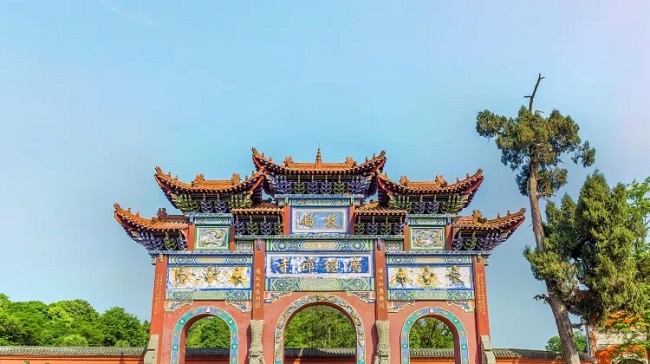
It is located in the Wolong Mountains, to the west of the city. This temple has a long history. It covers an area of 1.6 ha. Construction began in the Tang Dynasty (618-907), and was initially called Shifo Temple. It was built on the contours of the mountain. Guangde Temple, like any other Buddhist temples, includes Mahavira Hall and Tianwang Hall. There are more than 25 buildings attached, including pavilions and pagodas as well as halls. It houses valuable treasures such as the Yougu Pagoda, which was built in Tang Dynasty, and the wooden Shizhi Hall (1368-1644), and Shanji Pagoda Northern Song Dynasty (960-1127).
Guangde Temple, from several dynasties up to the present, has produced many outstanding Buddhist scholars. It has survived many hardships, but it has remained strong in the face of turbulent times. This important Buddhist Temple is attracting more tourists and worshippers to see and pray in southwest China because of its rich history and deep Buddhism culture.
China Dead Sea
It is located in Daying County and was formed underground 150 million years ago. It is located at 30 degrees north, making it a marvellous wonder. The 3,000-meter (9.843 feet) deep salt lake, whose salt content is 22 percent, is where the bitter water comes from. It's very similar to the Middle Eastern Dead Sea. It is possible to float around on it like a cork. It is rich in minerals, including rare elements like Na, K and Ca. Br, I have remarkable effects on high blood pressure, rheumatism and arthritis.
The underground saltwater was used to create an area with a man-made Dead Sea. The outdoor floating area covers 35,000 sq.m (8.6 acres), while the indoor floating area occupies 30,000 sq.m (7.4 acres), and can accommodate thousands. It is the most comfortable place to float in the sea all year round. They can also enjoy health benefits and a wide range of water recreation activities.
13. Shantang Street Suzhou
Tourists love Shantang Street in Jiangsu's northwest Suzhou. It is a pedestrian street along the river. It starts at the Changmen Gate, the west gate of the old city, and winds northwest along the northern bank the Shantang River to reach Tiger Hill. It stretches approximately 2.2 miles (seven Li), thus the name "Seven-Li Shantang".
Bai Juyi was transferred to Suzhou in 825 as the governor. He inaugurated the Shantang River Canal project there. Later, a parallel road was built on the north bank of the river. These developments made Shantang block a bustling transport and commercial hub. Because of its history of almost 1,200 years, the Shantang Street is known as "the First Street in Suzhou" and because it represents the local streets and alleys. It also has a connection with notable people and events.
Bantang Bridge can divide Shantang Street into two parts. The eastern part of Shantang Street, which is located in Changmen at Duseng Bridge, has houses and shops. The western part is a natural landscape, which is located at Tiger Hill. The entire block displays typical characteristics of south China's lower reaches of Yangtze River. The river flows under small, arched bridges that are interspersed with wooden boats drifting. It passes many old homes and shops along the busy street. This is a picture of an ancient, beautiful water town in South China. You can stroll around, sample local foods and buy souvenirs. To see the street scene from a new angle, you should go boating.
It is hard to resist the lure of the red lanterns below the eaves as night falls. Tourists couldn't help but exclaim, "Yes, this is Suzhou!"
14. Mount Emei ??? (E Mei Shan)
Mount Emei (Emeishan), is an area of cultural significance. It is where Buddhism was first established in China and where it has spread throughout the East. Mount Emei was the site of the first Buddhist temple built in China. It was constructed in the 1st Century CE. It was renamed the Guangxiang temple and given its current royal title of Huazang in 16.14. More than 30 temples were added to the mountain, including the Wannian Temple, which was established in the 4th Century and containing the Puxian bronze Buddha (7.85m high). There are also garden temples like the Qingyin Pavilion complex, consisting of pavilions, towers, platforms, and platforms that date back to the 6th century. The early 17th-century Baoguo Temple, the Ligou Garden (Fuhu Temple), and the Qingyin Pavilion. This is best seen in the Giant Buddha of Leshan, which stands at 71 meters tall. It was carved on the hillside at Xijuo Peak, overlooking the confluences of three rivers.
An inscribed tablet preserves a contemporary account of how the Giant Buddha was created. The 9th century Lingbao Pagoda as well as the Dafo (Giant Buddha Temple) Temple, both from the early Qing Dynasty, are associated monuments. Two important statues are found in the Wuyu Temple: the 9th Century Dashi bronze Buddha and Amithabha statue groups, both cast in iron and gilded. Mahao Crag is home to over 500 Han Dynasty tombs from the 1st through 4th centuries. They are notable for their exquisite carvings and calligraphic inscriptions.
Buddha Mount Emei
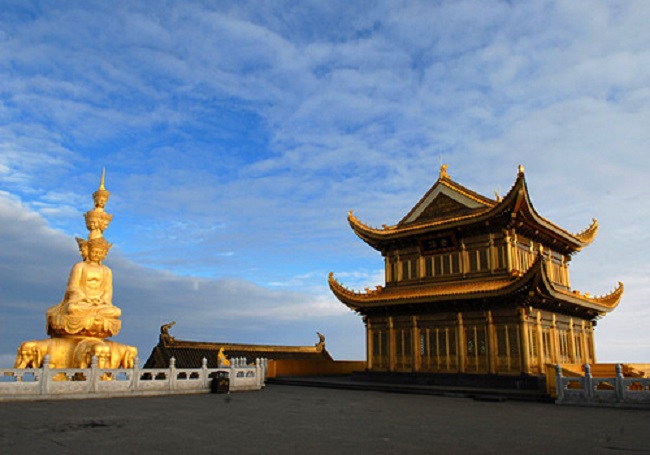
Mount Emei has a stunning scenic beauty. Because of its contribution to the introduction of Buddhism in China, it is also of significant spiritual and cultural significance. It is a cultural landscape of high order because it has so many cultural monuments, especially of traditional architecture, that are consciously placed within the natural environment.
The extraordinary rich vegetation of Mount Emei, which includes subtropical evergreen and subalpine pine forest, is another reason for its fame. The property covers an area of 15,400ha in two distinct areas, the Mount Emei Scenic Areas and the Leshan Giant Buddha Scenic Areas. It is an area full of natural beauty where the human element has been seamlessly integrated with skillfulness and subtlety.
Four Natural Wonders of the Mountain
- Sunrise at Emeishan: The sunrise on Mount Emei is unique because it is more than 3000m above sea level. It is best to watch the sunrise during summer and winter at 6:00am.
- Sea of cloud: The cloud that covers the mountain is mostly found at a height of approximately 2000m. No matter whether guests climb the mountain by foot or cable cars, the place where the cloud scenery changes is at the Jiulao cave. Before reaching Jiulao Cave, the cloud is above your head. From Jiulao cavern to Xixiang chi (elephant swimming pool), guests might find the clouds underfoot between Xixiang chi and the peak of Golden summit. You can best see the sea of clouds between 9:00-10:00 AM and 15:00-16:00 PM in the afternoon.
- The Buddha's Halo (Brocken Bow): People standing on the Peak of Emei Mountain's golden summit may be able to see a bright halo (red or purple). In foggy days, this could look like a man's shadow moving in and out of the halo. This natural phenomenon is known as the broken bow or 'the precious lamp of Mount Emei'. The phenomenon is caused by the reflection of sunlight, fog, and clouds. Buddhists believe it to be caused by the diffraction. The best time to view the Broken bow is between 15:00 and 16:30 in the afternoon. It appears approximately every 5 days.
- The vigil (or the holy lights, or the saint lights): This holy light is visible only at night. It appears suddenly in the dark valley and can be seen floating in the air, either more or less brighter than the rest. Scientists are still unsure of the scientific explanation for the vigil light. Although we don't know if it is the glowworm, wildfire or a bacterium, tourists might be more fortunate to see the holy light than the Buddha's halo. It is best to view the holy light on a dark night, without moonlights, particularly after rainy days in the first and last days of each month of the Chinese lunar year. Lingyanshi Temple, Fuhu Temple, Huayanding and Xixiangchi are the best places to view the vigil lights. However, the Golden Summit is the ideal place.
15. Nanshan Temple, Sanya
Nanshan Temple, a Buddhist temple, is located in Sanya Province, Hainan Province. It is located 40 km (25 miles) away from Sanya's downtown. It is located in the Nanshan Buddhism Cultural Zone. Nanshan Temple houses the largest statue of Avalokitesvara Guanyin, the goddess of infinite compassion in Buddhism. At 108m high, the statue of Avalokitesvara overlooks the waters of South China Sea and Nanshan Mountain. It was built in six years. Construction began in November 1995. From east to west, the temple measures 188m wide and 416 meters from south to north. Nanshan Temple has a total area of 40,000 square meters (10 acres) and several copies of Tang Dynasty (618-907) architecture.
The Nanshan Temple (South Mountain Temple), is located 40 km (25 miles) away from Sanya City in Hainan Province. It is one of the most popular attractions within the Nanshan Culture Tourism Zone. It covers an area of 400m (66 acres), and is the largest Buddhist preaching site since the foundation of the People's Republic of China.
Nanshan Temple is located at the foot Nanshan Mountain. It is an auspicious area known for Chinese Buddhist culture and emphasis on longevity-happiness.
This temple has a total area of 40,000 square meters (10 acres) and features several replicas from Tang Dynasty (618-9077) architecture. Two Buddha figures guard the temple's entrance, the Renwang Gate (Mountain Gate). Seven Buddhist figures are also enshrined within the Doushuai Adytum, or Hall. In the middle of the Hall is the Maitreya Buddha (Sanskrit: Mile in Chinese), with two Bodhisattvas at each end. The Four Heavenly Kings are situated around these three Buddhist images. They have the duties of Buddhist guardians and bring good weather and abundant harvest. A porch leads to Jin Tang from the Doushuai Adytum. In the Tang Dynasty's time, it was also known as Daxiongbaodian (Hall of Ceremony). The three main Buddha images are here: the Sakyamuni (Chinese Yaoshiwang), the Bhaisajyaguru, and the Amitabha. These halls make up the Temple's main areas.
16. Xumishan Grottoes ?????
There are more than 130 grottoes along the red sandstone cliffs at Xumishan. This is a Buddhist enclave on one of the major stretches of Silk Road. The 600-year-old period between the fourth century A.D. and the tenth century A.D. saw many grottoes decorated with wall paintings and statues. This region was also a popular pilgrimage spot, as it was associated with Mount Sumeru (Xumishan, in Chinese). Each grotto has its own iconographic program and was developed in eight distinct clusters along the eight mountain peaks. The Big Buddha Mansion is the largest, and houses a statue of Buddha measuring 20 meters tall. It dates back to the Tang period (618-908).
The caves have 70 wall paintings and statues. Unadorned grottoes were thought to have been used as monk's quarters. The Xumishan Grottoes were designated a National Level Cultural Relic Protection Site in China. However, they are at risk from natural causes such as wind, sand erosion and water damage. The site has been threatened by vibrations from a new road that runs through the area. However, the local government recently promised to divert the road from the grottoes. It is important to reconsider and reverse previous emergency conservation measures such as the reconstruction of concrete elements. The State Bureau of Cultural Relics of China is keen to protect the site. It hopes that inclusion on the 2008 Watch List will increase public awareness of the significance of Xumishan and encourage international efforts to conserve this beautiful, but little-known, site.
History
Excavated during the Northern Wei Dynasty's middle and late periods, Xumishan Grottoes. The Northern Zhou Dynasty was a crucial phase in the development of China. The Northern Wei and Northern Zhou grottoes are built in central pillar style.
Sui and Tang Dynasties had many grottoes. Grottoes were a motifs that had one Buddhist, two Bodhisattvas, and two followers at one time during the Sui Dynasty. The Tang Dynasty Xumishan Grottoes record a very prosperous period of grottoes. They have a large number and large scale of grottoes of exquisite craftsmanship. The Silk Road was the location of Xumishan Grottoes.
Structure
The caves are at risk from erosion by wind and rain, vandalism, earthquakes, and vandalism over a long period of time. 20 statues are located in five scenic locations: Dafo Tower and Zisun Palace, Yuanguang Temple, Xiangguo Temple, Taohua Cave, and Yuanguang Temple. Most statues in the well-preserved caves No.45 or 46 are larger than humans. Although No.51 was destroyed by earthquakes, we can still draw an outline. It is composed of a prechamber, main room, right and left chambers. Main chamber measures 26 meters in width, 12 meters deep, 12 metres long, and 7 meters high. Zisun Palace is located just beyond Dafo Tower. Here are most of the grottoes from Northern Wei Dynasty. The No.14 cave, located in front of Zisun Palace's cliff, is the oldest one to be excavated. The inside cave's Buddhist statue was simple in color and sculpted similar to the one in Yungang Dunhuang . There are 40 statues that measure 6 to 7 m in the No.45 and 46 caves of Yuanguang Temple, and in the No.51-67 and 70 caves at Xiangguo Temple.
Style
Different styles of different ages are evident in different grottoes from the Northern Wei Dynasty, Sui and Tang Dynastie in Xumishan. The Northern Dynasty Buddha's nose bridge is very high, and still reflects Indian Buddhism. Buddha of Sui Dynasty appears to have a long body with a short leg, square face, and clumsy images. The Buddha of Tang Dynasty is a perfect example. It is a large figure with a beautiful, full body. The extravagant and colorful clothing reflects the exceptional artistic temperament of Tang Dynasty. Xumishan Grottoes are different from other grottoes that only dig in one cliff. They go into 8 separate mountains. Its unique structure includes a bridge that connects mountains.
The Best Time to Visit
Xumishan Grottoes can be found in a remote area, so it is important to choose a good time to travel. Summer is best, although spring, autumn, and winter are also good options. Xumishan Grottoes differ from the other four great grottoes in that you must climb mountains. This means that rainy and snowy days are not ideal. You should avoid visiting at noon in the summer, as it will be burned at noon. Also, you will need lots of water to keep you hydrated. Self-driving can be difficult and not very easy, especially when it is rainy or snowy. It is better to not smoke when you visit grottoes.

